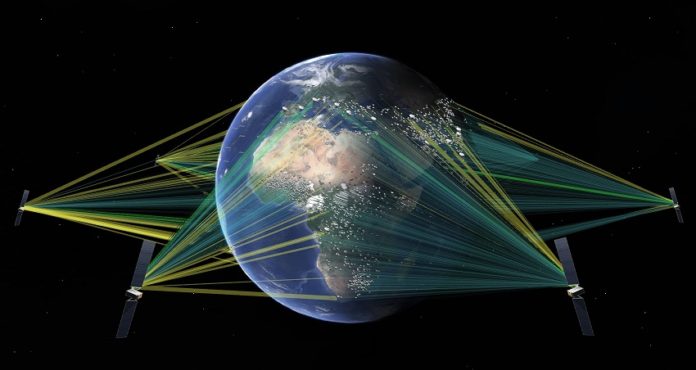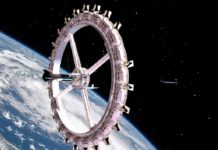Yesterday, SES announced plans for a new Medium Earth Orbit (MEO) network known as O3b mPower, which will consist initially of a seven satellite constellation manufactured by Boeing, scheduled to be operational in 2021.
The announcement was accompanied by an hour-long press conference held in Paris, attended by SES President and CEO Karim Michael Sabbagh, CEO of SES Networks Steve Collar, and Boeing Satellite Systems Chairman and CEO Paul Rusnock.
Both SES’ press release and the press conference were relatively vague, with neither SES nor Boeing going into many technical or financial details of O3b mPower. Indeed, SES has emphasized only three specific characteristics of the system – that it will have 30,000 fully-shapeable and steerable beams that can be shifted and switched in real time, it will provide coverage to an area of nearly 400 million square kilometres, and that it will be capable of delivering multiple terabits of throughput.
Despite consisting mostly of rhetoric, a few other details were revealed during the press conference, and these are the highlights:
A new Boeing design for satellites
Although based on current O3b satellites, which have been adapted from Boeing’s 702 bus design, the seven O3b mPower satellites will essentially be a new design. Most importantly, its main component will be large, proprietary electronics phased array.
Said Rusnock, “The major change is the highly integrated electronics phased arrays payload system. It’s quite a departure from our standard platform. It’s very light, it’s very powerful in how it can produce capability and get the resources where they need to go. To be quite frank, when you open up the spacecraft, you’re seeing bus components in there, but very little payload. It’s all on this one piece”.
Also, each satellite will have a modular design for rapid testing and production, and will use 3D printed parts.
Added Rusnock, “This new architecture enables us to really test out the whole payload system as a single entity and with built-in tests we’ll be able to get through that very rapidly. How we build the rest of the bus will be a very modular approach. We’re going to look at 3D printing…and we plan on incorporating electric propulsion”.
Terminals will use edge computing
Although SES has not yet announced its partners for terminals, it has described the new Customer Edge Terminals as ranging from small to very large ones, with edge computing and remote monitoring for each.
Said Collar, “[We have] the ability to see that terminal on our network so we can provide remote monitoring, we know the health of that terminal, but we can also provide software updates to that terminal. We can provide additional capabilities and functionalities. We’re going to include storage capabilities into these terminals. So again, we can add applications..if a customer wants a firewall, we can download that and provide that software to them rather than having to go put another box in the terminal.”
New satellites will communicate with existing ones
Through the use of software (and perhaps the phased array), O3b mPower satellites will communicate with existing SES satellites. Our guess is that the network will be able to leverage the capacities of other satellites on-demand.
Said Collar, “We’re going to have software-defined capabilities that will route our traffic and route our customers’ traffic intelligently between our GEO network and our MEO network, whether that be based upon application, or whether that be based on cost.”
Lower cost, able to replace GEO satellites
When speaking of the satellites, Rusnock mentioned that their design would enable four satellites to be launched at the same time. And while SES decline to mention the exact cost or financials of the network, both Sabbagh and Collar suggested that they would be much lower than current O3b satellites. Sabbagh added that with O3b mPower, SES will not be replacing 2 of its current GEO satellites.
Said Sabbagh, “…two of our upcoming replacement legacy GEO satellites will not be renewed because through this new system, we’re able to go much further with less investment and capabilities. It introduces improvements in capital allocation going forward, starting with 2 GEO satellites that we have already identified.”
Added Collar, “Obviously this is a significant investment on behalf of SES and SES Networks, but….it’s built on the fundamentals of a system that exists today. If you compare the investment needed to deliver a system like this with any other way of doing it…we’re able to deliver this kind of system at economics that no one else can get close to.”
Conclusion
It appears that O3b mPower will take the cloud computing model to space, in that it will be highly configurable and adaptable; SES has emphasized that the network’s beams will be targeted only in areas with customers, and that there will be no wastage or inefficiencies. This implies that the network has the capability to shift data between satellites in near real-time. The company says that more details, such as their terminal and launch partners, will be revealed in the coming months.







